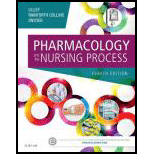
(1)
To determine:
What type of diuretic was probably prescribed for G. at this time? Explain your answer.
Case summary:
Hypertension was diagnosed in G., who is 30 years of age. Both her mother and sister have hypertension, and both were also in their thirties when it was diagnosed. G’s most current blood pressure reading is 150/96 mm/Hg, and for this reason, the nurse practitioner recommended therapy with captopril (Capoten), light exercise in the form of walking, and relaxation therapy. After a month of therapy, G.’s blood pressure is 145/86 mm Hg. Stress reduction has been the biggest obstacle in her treatment because she is a lawyer with a prominent law firm and has found that her blood pressure is consistently elevated (160/100 mm Hg) whenever she measures it at work. At this follow-up visit, she is also given a prescription for a diuretic to help with her blood pressure control. She plans to consult a therapist to work on stress-reduction techniques and to begin exercising regularly.
(2)
To determine:
The possible adverse effects G. needs to be aware of while taking captopril.
Case summary:
Hypertension was diagnosed in G., who is 30 years of age. Both her mother and sister have hypertension, and both were also in their thirties when it was diagnosed. G’s most current blood pressure reading is 150/96 mm/Hg, and for this reason, the nurse practitioner recommended therapy with captopril (Capoten), light exercise in the form of walking, and relaxation therapy. After a month of therapy, G.’s blood pressure is 145/86 mm Hg. Stress reduction has been the biggest obstacle in her treatment because she is a lawyer with a prominent law firm and has found that her blood pressure is consistently elevated (160/100 mm Hg) whenever she measures it at work. At this follow-up visit, she is also given a prescription for a diuretic to help with her blood pressure control. She plans to consult a therapist to work on stress-reduction techniques and to begin exercising regularly.
(3)
To determine:
G. tells that she uses an over-the-counter pain reliever for occasional headaches. What potential interaction is her concern?
Case summary:
Hypertension was diagnosed in G., who is 30 years of age. Both her mother and sister have hypertension, and both were also in their thirties when it was diagnosed. G’s most current blood pressure reading is 150/96 mm/Hg, and for this reason, the nurse practitioner has recommended therapy with captopril (Capoten), light exercise in the form of walking, and relaxation therapy. After a month of therapy, G.’s blood pressure is 145/86 mm Hg. Stress reduction has been the biggest obstacle in her treatment because she is a lawyer with a prominent law firm and has found that her blood pressure is consistently elevated (160/100 mm Hg) whenever she measures it at work. At this follow-up visit, she is also given a prescription for a diuretic to help with her blood pressure control. She plans to consult a therapist to work on stress-reduction techniques and to begin exercising regularly.
(4)
To determine:
G. states that she and her husband are planning to start a family in 1 year. What will you, as her nurse, tell her about pregnancy and therapy with these drugs.
Case summary:
Hypertension was diagnosed in G., who is 30 years of age. Both her mother and sister have hypertension, and both were also in their thirties when it was diagnosed. G’s most current blood pressure reading is 150/96 mm/Hg, and for this reason, the nurse practitioner has recommended therapy with captopril (Capoten), light exercise in the form of walking, and relaxation therapy. After a month of therapy, G.’s blood pressure is 145/86 mm Hg. Stress reduction has been the biggest obstacle in her treatment because she is a lawyer with a prominent law firm and has found that her blood pressure is consistently elevated (160/100 mm Hg) whenever she measures it at work. At this follow-up visit, she is also given a prescription for a diuretic to help with her blood pressure control. She plans to consult a therapist to work on stress-reduction techniques and to begin exercising regularly.
Trending nowThis is a popular solution!

Chapter 22 Solutions
Pharmacology and the Nursing Process, 8e
 Phlebotomy EssentialsNursingISBN:9781451194524Author:Ruth McCall, Cathee M. Tankersley MT(ASCP)Publisher:JONES+BARTLETT PUBLISHERS, INC.
Phlebotomy EssentialsNursingISBN:9781451194524Author:Ruth McCall, Cathee M. Tankersley MT(ASCP)Publisher:JONES+BARTLETT PUBLISHERS, INC. Gould's Pathophysiology for the Health Profession...NursingISBN:9780323414425Author:Robert J Hubert BSPublisher:Saunders
Gould's Pathophysiology for the Health Profession...NursingISBN:9780323414425Author:Robert J Hubert BSPublisher:Saunders Fundamentals Of NursingNursingISBN:9781496362179Author:Taylor, Carol (carol R.), LYNN, Pamela (pamela Barbara), Bartlett, Jennifer L.Publisher:Wolters Kluwer,
Fundamentals Of NursingNursingISBN:9781496362179Author:Taylor, Carol (carol R.), LYNN, Pamela (pamela Barbara), Bartlett, Jennifer L.Publisher:Wolters Kluwer, Fundamentals of Nursing, 9eNursingISBN:9780323327404Author:Patricia A. Potter RN MSN PhD FAAN, Anne Griffin Perry RN EdD FAAN, Patricia Stockert RN BSN MS PhD, Amy Hall RN BSN MS PhD CNEPublisher:Elsevier Science
Fundamentals of Nursing, 9eNursingISBN:9780323327404Author:Patricia A. Potter RN MSN PhD FAAN, Anne Griffin Perry RN EdD FAAN, Patricia Stockert RN BSN MS PhD, Amy Hall RN BSN MS PhD CNEPublisher:Elsevier Science Study Guide for Gould's Pathophysiology for the H...NursingISBN:9780323414142Author:Hubert BS, Robert J; VanMeter PhD, Karin C.Publisher:Saunders
Study Guide for Gould's Pathophysiology for the H...NursingISBN:9780323414142Author:Hubert BS, Robert J; VanMeter PhD, Karin C.Publisher:Saunders Issues and Ethics in the Helping Professions (Min...NursingISBN:9781337406291Author:Gerald Corey, Marianne Schneider Corey, Cindy CoreyPublisher:Cengage Learning
Issues and Ethics in the Helping Professions (Min...NursingISBN:9781337406291Author:Gerald Corey, Marianne Schneider Corey, Cindy CoreyPublisher:Cengage Learning





